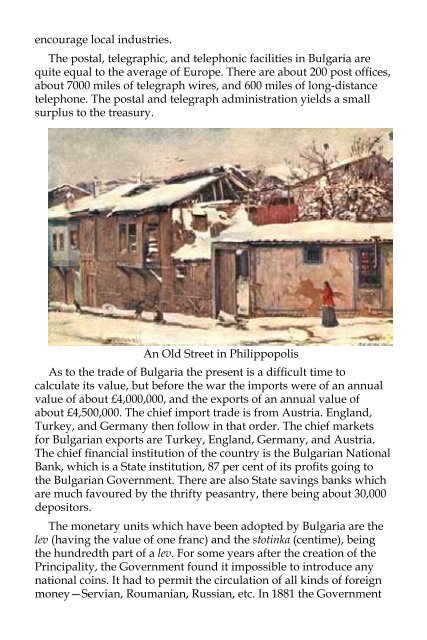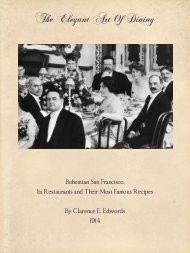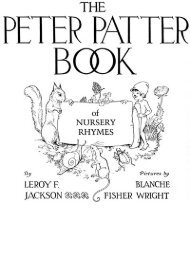Bulgaria e-book - iMedia
Bulgaria e-book - iMedia
Bulgaria e-book - iMedia
Create successful ePaper yourself
Turn your PDF publications into a flip-book with our unique Google optimized e-Paper software.
encourage local industries.<br />
The postal, telegraphic, and telephonic facilities in <strong>Bulgaria</strong> are<br />
quite equal to the average of Europe. There are about 200 post offices,<br />
about 7000 miles of telegraph wires, and 600 miles of long-distance<br />
telephone. The postal and telegraph administration yields a small<br />
surplus to the treasury.<br />
An Old Street in Philippopolis<br />
As to the trade of <strong>Bulgaria</strong> the present is a difficult time to<br />
calculate its value, but before the war the imports were of an annual<br />
value of about £4,000,000, and the exports of an annual value of<br />
about £4,500,000. The chief import trade is from Austria. England,<br />
Turkey, and Germany then follow in that order. The chief markets<br />
for <strong>Bulgaria</strong>n exports are Turkey, England, Germany, and Austria.<br />
The chief financial institution of the country is the <strong>Bulgaria</strong>n National<br />
Bank, which is a State institution, 87 per cent of its profits going to<br />
the <strong>Bulgaria</strong>n Government. There are also State savings banks which<br />
are much favoured by the thrifty peasantry, there being about 30,000<br />
depositors.<br />
The monetary units which have been adopted by <strong>Bulgaria</strong> are the<br />
lev (having the value of one franc) and the stotinka (centime), being<br />
the hundredth part of a lev. For some years after the creation of the<br />
Principality, the Government found it impossible to introduce any<br />
national coins. It had to permit the circulation of all kinds of foreign<br />
money—Servian, Roumanian, Russian, etc. In 1881 the Government<br />
put into circulation two million francs of <strong>Bulgaria</strong>n copper money,<br />
but these, as well as the twelve millions of silver money which<br />
were issued in 1883-1884, proved quite insufficient to drive away<br />
the foreign money, so that the latter continued to be used in all<br />
commercial transactions. It was not until 1887 that the Government<br />
prohibited the circulation of Servian and Roumanian coins. Later<br />
Russian money was also prohibited, and there is now a purely<br />
national currency. On the outbreak of the war in 1913 a moratorium<br />
was declared, and the internal finance of the country was managed<br />
on a paper currency. The confidence of the people kept this paper<br />
money at its full value. I was never able to get any concession in<br />
exchanging English gold for paper.<br />
<strong>Bulgaria</strong>, notwithstanding all the preoccupations of a young<br />
nation, finds time to encourage the arts. As the illustrations to<br />
this volume will show, there is a flourishing school of native art<br />
in <strong>Bulgaria</strong>. To Nicolas Pavlovitch (born 1835, died 1889) belongs<br />
the honour of having been the father of modern <strong>Bulgaria</strong>n art. He<br />
graduated at the academies in Vienna and Munich, and, after visiting<br />
the various museums in Dresden and Prague, exhibited during 1860<br />
in Belgrade two pictures whose subjects had been suggested by<br />
ancient <strong>Bulgaria</strong>n history. He then went to Petrograd and Moscow.<br />
In 1861 he returned to his native country, where he endeavoured, by<br />
means of his lithographs and pictures of subjects both ancient and<br />
modern, to stimulate his compatriots to political and intellectual life.<br />
He also tried to reform and modernise church painting in accordance<br />
with the requirements of modern artistic technique, and made two<br />
unsuccessful attempts at opening a school of painting. He painted<br />
portraits, and, in the palace of the Pasha of Roustchouk, he illustrated<br />
a Turkish history of the Janissaries.<br />
In 1896 a State school of painting was founded at Sofia, and there<br />
is now a fine art gallery in the capital. But most of the artistic impulse<br />
has come from abroad, and the most notable names in <strong>Bulgaria</strong>n art<br />
after that of Pavlovitch are Piotrovsky (Polish), Boloungaro (Italian),<br />
de Fourçade (French), Sliapin (Russian). The first art exhibition was<br />
organised in 1887 by Ivan Angeloff, teacher in the Gymnasium of<br />
Sofia and a graduate of the Munich Academy of Fine Arts. This<br />
exhibition, which contained three pictures painted in <strong>Bulgaria</strong> and a<br />
number of sketches and studies dating from the artist’s student days<br />
in Munich, as well as drawings by students of the Gymnasium, was<br />
held in one of the drawing-rooms of the Gymnasium in honour of the<br />
Prince, who had recently been elected to the <strong>Bulgaria</strong>n throne. Some





